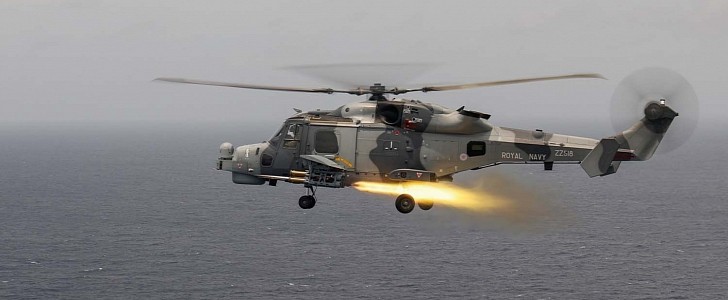A Royal Navy Wildcat helicopter has fired for the first time Martlet lightweight missiles during an operation in the Pacific region with the UK Carrier Strike Group. The new missile system is intended to protect the Royal Navy's new aircraft carriers from attacks by swarms of small boats.
The weapons were launched at an inflatable target in the sea known in the navy as the "big red tomato". This is the first time when the Royal Navy used the Martlet in frontline operations. The recent live firing exercise follows extensive testing at ranges off the UK coast by the Yeovilton-based Wildcat Maritime Force.
The new missile system is designed to bring extended protection around the Royal Navy's aircraft carriers, providing offensive and defensive capabilities against small boats and fast attack craft.
Captain James Blackmore, Carrier Strike Group's Air Wing Commander, explains that the "Martlet is a new air to surface lightweight multi-role missile recently introduced into service for the Wildcat helicopter and that may pose a threat to the Carrier Strike Group."
Weighing 13 kg (29 lbs) and with a range of more than 6 km (3.7 miles), the laser-guided missile is capable of accelerating to a top speed of Mach 1.5 in only 0.3 seconds.
The Wildcat HMA Mk2 helicopter is outfitted with an advanced electro-optical sensor suite located in the aircraft's nose. This enables it to identify threats at a significant range both during the day and at night. The helicopter's nose turret also has a laser target designator, which sends out a coded laser beam to guide the Martlet to its target.
According to the Royal Navy, Wildcats can currently carry up to 20 laser-sensor missiles that can be launched against both stationary and moving targets.
"This first firing during an operational deployment not only gives confidence in the end to end weapon kill chain but also offers an overt demonstration of one of the many strike capabilities provided by the Air Wing from within the Task Group," said Captain Blackmore.
The new missile system is designed to bring extended protection around the Royal Navy's aircraft carriers, providing offensive and defensive capabilities against small boats and fast attack craft.
Captain James Blackmore, Carrier Strike Group's Air Wing Commander, explains that the "Martlet is a new air to surface lightweight multi-role missile recently introduced into service for the Wildcat helicopter and that may pose a threat to the Carrier Strike Group."
Weighing 13 kg (29 lbs) and with a range of more than 6 km (3.7 miles), the laser-guided missile is capable of accelerating to a top speed of Mach 1.5 in only 0.3 seconds.
The Wildcat HMA Mk2 helicopter is outfitted with an advanced electro-optical sensor suite located in the aircraft's nose. This enables it to identify threats at a significant range both during the day and at night. The helicopter's nose turret also has a laser target designator, which sends out a coded laser beam to guide the Martlet to its target.
According to the Royal Navy, Wildcats can currently carry up to 20 laser-sensor missiles that can be launched against both stationary and moving targets.
"This first firing during an operational deployment not only gives confidence in the end to end weapon kill chain but also offers an overt demonstration of one of the many strike capabilities provided by the Air Wing from within the Task Group," said Captain Blackmore.











